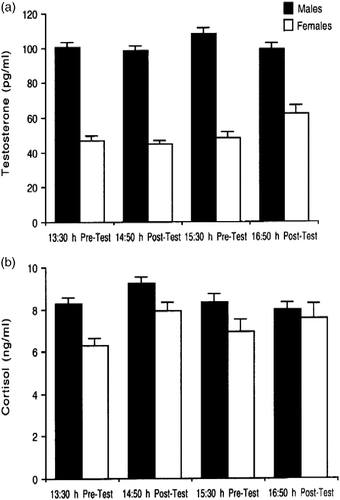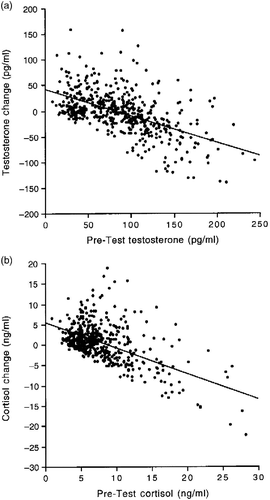Figures & data
Figure 1 (a) Correlation between pre-test and post-test salivary testosterone concentrations in males and females (r = 0.57; n = 501; p < 0.0001). (b) Correlation between pre-test and post-test salivary cortisol concentrations in males and females (r = 0.42; n = 501; p < 0.0001).

Figure 2 (a) Correlation between pre-test salivary testosterone and cortisol concentrations in males and females (r = 0.29, n = 501, p < 0.0001). (b) Correlation between post-test salivary testosterone and cortisol concentrations in males and females (r = 0.30, n = 501, p < 0.0001).

Figure 3 (a) Pre- and post-test salivary testosterone concentrations (mean ± SEM) in males and females in early and late tests. Times of test are indicated on the x-axis. Males had significantly higher testosterone level than females in both the pre-test and the post-test conditions (both p < 0.0001). Testosterone concentration was significantly higher in late than in early samples, irrespective of gender, but only in the post-test condition (p = 0.001). (b) Pre- and post-test salivary cortisol concentrations (mean ± SEM) in males and females in early and late tests. Males had significantly higher cortisol concentration than females in both the pre-test (p < 0.0001) and the post-test conditions (p = 0.03). Cortisol concentration was significantly higher in early than in late samples, irrespective of gender, but only in the post-test condition (p = 0.002). See Results text for detailed statistical results. Sample sizes are: males, early test, n = 201; late test, n = 147; females, early test, n = 101, late test, n = 52. Sample sizes are the same for pre- and post-test data, and for testosterone and cortisol data.

Figure 4 (a) Correlation between salivary pre-test testosterone concentrations and the difference between post-test and pre-test testosterone concentrations (r = 0.55; n = 501; p < 0.0001). (b) Correlation between pre-test salivary cortisol concentrations and the difference between post-test and pre-test cortisol concentrations (r = 0.56; n = 501; p < 0.0001). Data are for all subjects.

Table I. Mean ± SEM testosterone (T, pg/ml) and cortisol (cort, ng/ml) concentrations and their residuals in male and female study participants with respect to relationship and marital status.
Figure 5 Residuals for salivary cortisol concentrations in unpaired individuals (n = 254), paired but unmarried individuals (n = 69), and married individuals with (n = 166) and without children (n = 24). Data for both males and females are presented. See text for statistical results. Values are mean ± SEM. The difference among the four groups is statistically significant (p = 0.001); see Results text for detailed statistical results. Unpaired individuals had significantly higher cortisol residuals than both married individuals without children (Bonferroni–Dunn post hoc test, p < 0.05) and married individuals with children (Bonferroni–Dunn post hoc test, p < 0.05).

